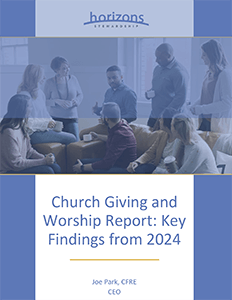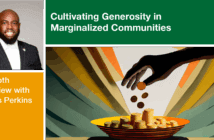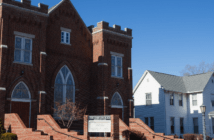
What are the current church giving and worship attendance trends? In this conversation, Joe Park unpacks key trends in worship attendance and giving from Horizons Stewardship’s Church Giving and Worship Report: Key Findings from 2024. He emphasizes digital engagement, discipleship, and strategic ministry planning, while highlighting the importance of adaptive leadership, consistent generosity messaging, and authentic relationships.
Listen on Apple Podcasts | YouTube Music | Spotify
Watch on YouTube

- Transcript — Click or Tap to Read
-
Announcer: Leading Ideas Talks is brought to you by the Lewis Center for Leadership of Wesley Theological Seminary in Washington, DC. Subscribe free to our weekly e-newsletter, Leading Ideas, at churchleadership.com/leadingideas.
Leading Ideas Talks is also brought to you by the Congregational Giving Profile. Nearly every aspect of the church is touched by its financial resources; so it’s vital to track giving and expenses accurately. The Congregational Giving Profile helps you better track your congregation’s giving and spending patterns to more accurately predict financial surpluses and shortfalls. Learn more at churchleadership.com/cgp.
What are the current church giving and worship attendance trends? In this conversation, Joe Park unpacks key trends in worship attendance and giving from Horizons Stewardship’s Church Giving and Worship Report: Key Findings from 2024. He emphasizes digital engagement, discipleship, and strategic ministry planning, while highlighting the importance of adaptive leadership, consistent generosity messaging, and authentic relationships.
Jessica Anschutz: Welcome to Leading Ideas Talks, a podcast featuring thought leaders and innovative practitioners. I am Jessica Anschutz, the Interim Director of the Lewis Center for Church Leadership, and I am your host for this Leading Ideas talk. Joining me is Joe Park, CEO and Principal of Horizon Stewardship. The focus of our podcast today is trends in church giving and worship attendance, drawing on Horizon Stewardships ‘Church Giving and Worship Report.’ Welcome Joe. I look forward to our conversation today.
Joe Park: Thank you, Jessica. I’m excited to be here.
Jessica Anschutz: Before we dig into the recent report, I think it would be helpful for our listeners to hear a little bit about Horizon Stewardship, and so what does our audience need to know?
Joe Park: We’ve been in this work for over 30 years. We were started by a United Methodist pastor, who was appointed to extension ministry, and since that point, we’ve grown to a team of about 40 folks, having helped churches and faith-based nonprofits raise over 10 billion in capital dollars. And we don’t have a way to count annual giving or plan giving, and we see ourselves really in the discipleship business. We understand generosity to be a byproduct of discipleship. And so, our perspective is deeper than just how to pass the offering plate better, or fundraising, if you will.
Jessica Anschutz: Thank you for that, Joe. I appreciate the context. Today, we’re going to focus on your recent findings in the ‘Church Giving and Worship Report.’ So, I’d like for you to give a little bit of a background of the report for our listeners.
Joe Park: Yeah, we began this report about five years ago. We have around 45,000 churches and church leaders who follow our blog, and we thought it would be a good idea to actually ask them what they’re experiencing on the ground. We used to do it every six months because so much was changing, and in 2023, we moved to just doing it once a year. So, we invite churches of all sizes from around the country to participate, and then we roll that up into the report that you’re talking about. And people can find that on Horizons.net, or more specifically, if they want to go to our free resource library: giving365.com. They can download the report and some infographics we’ve created around it, as well as the blog that talks about some of the things that we’re gonna cover here today.
Jessica Anschutz: Thank you for that, and we will link to those sites on our podcast page for easy access. So, what are some of the trends that you all have identified as far as worship goes?
Joe Park: Well, it uh… that’s a multi-layered question. Essentially, what we’re seeing is that since Covid, worship had been increasing through 2023, and for the first time since the decline in Covid, we’re seeing worship attendance across the board—in all size churches—beginning to decline. Now, let me tell you how we’re defining worship. We’re defining it as: in-person attendance, online and on demand attendance. And so, this does include the increase in online giving. And just let me make a comment about that for churches that may not think that’s a significant part of worship. Across the board, we do another study with a partner of ours, the Unstuck Group, and in that study, we saw that churches (now this is churches of all sizes) are seeing 60 in-person worshipers for every hundred, excuse me, 60 online worshipers for every hundred in worship, in-person worship. So, the way that we had ’em count, there was just a connection where somebody stayed on, they stayed connected for 12 minutes or longer. And that’s significant when for every hundred people you have in worship, 60 across the country are worshiping online.
We’re also seeing significant shifts. These are long-term trend shifts by worship, by the size of church. Now, we didn’t measure churches by worship attendance. We measured them by annual giving because that is a very finite number. People understand that. And so, churches in our survey are divided by size that way. And what we’re seeing is that the largest churches, those that have more than $5 million in annual giving are really doing remarkably well. They saw, continued to see, an increase in worship attendance, and the other size groups actually all saw falling worship attendance. And so, yes, as a whole, worship attendance was down from in 2024 compared to 2023, except in the very largest of churches.
Jessica Anschutz: I think that’s a really helpful distinction to make. Joe, you’ve given us a nice picture of worship trends. What are some of the specifics, as they relate to churches of different sizes?
Joe Park: I’m reading right now off of our report. And so, for instance, churches with 5 million dollars in annual giving and up – 91% of them saw an increase. If we, when we drop down to a million to 5 million – 71% saw an increase, and as we drop down to a half million to a million – 65%. Those a hundred thousand to 499 – only 44%. In churches that are worship that have annual giving of less than a hundred thousand dollars – only 29 percent saw an increase in giving.
So, the numbers say that the larger churches are doing better. The larger the church, the difference is significant from the smallest to the largest churches. So, we’re gonna see that trend repeating itself in the giving as well.
Jessica Anschutz: Great. So, let’s talk about the giving. What giving trends did you see?
Joe Park: So, we’re seeing the same trends in worship repeating themselves in giving. The largest churches, 79% saw an increase in giving. If we go to churches a million to 5 million, 56% saw an increase. And then that, essentially, is flowing its way down to the very smallest churches; only 39% saw an increase in giving.
So, the reverse of that is we see higher numbers of smaller churches with decreasing giving because they had the option of staying essentially the same. Higher numbers are decreasing in smaller churches, whereas larger churches, only 8% of those reporting, said that they had experienced a year over year decrease in giving.
Jessica Anschutz: That isn’t surprising, but it does pose some challenges, especially for those who are in the smaller churches. What opportunities do you see for church leaders given these realities?
Joe Park: Well, I think there are opportunities in every church. Even though the statistics are more troubling in the smaller churches, there’s still a significant number of smaller churches that are thriving. So, I don’t think size limits the ability to grow and thrive. It’s really more internal practices. So, I think the opportunities are largely the same across churches. Change the specifics of your community, your mission field, that sort of thing, will drive that more than just broad opportunities.
Another opportunity that I see is that 67% of all giving continues to be motivated by spiritual or religious reasons. So, two thirds of all giving is still spiritually or religiously motivated, and that leaves a lot of resources out there. We’re only seeing 24% of total giving coming to the church, even though the super majority of giving is actually motivated by the work that we do. So, there’s a huge opportunity to grow into that, to really make the case that we, the local church, are good stewards of the dollars that are already being given.
And this may come as a little bit of a surprise to folks, if you don’t follow trends in giving, but American giving, as a percentage of disposable income after tax income, is remarkably flat. If you look at it in five-year spans over the last 40 years, it just stays right at 2%. We’ve seen it go to 1.7. We’ve seen it go to 2.3. But there is a perception in churches that a poor economy or inflation or something is going to significantly change people, the amount that people give, and that just has not rung true over time. So, even in these times of uncertainty, there’s still a lot of resources that are available and motivated by our primary work.
Jessica Anschutz: So, what can church leaders do to begin to tap into those resources, or to do a more effective job of tapping into those resources?
Joe Park: There are a lot of different things, but in the accompanying blog to this report, we looked at corollaries between churches that are thriving, regardless of size, and churches that were struggling. For the churches that are thriving, we see a willingness among leaders to adapt. Our world is changing. Our mission field is changing. And while Christ’s message is not changing, how we deliver that, how we engage people, does need to adapt and change. So, churches that are trying to hold on to something that work for them in the past, instead of leaning into what might work in the future are struggling.
The second thing is churches that are thriving are much more focused on discipleship and engaging; but the success a church has in moving people from worship into small groups, Sunday school classes, some form of community, and spiritual formation, and into serving, are significantly more resourced than churches that do less of a job there.
And the last is to embrace – technology. We’re all struggling with less resources actually coming to the church today. So, technology provides us an opportunity to level that field, to be more efficient at delivering our ministries. And we can cover that more in detail if you want, but those were the three chunks we saw that were most important.

Leading Ideas Talks is also brought to you by the Congregational Giving Profile. Nearly every aspect of the church is touched by its financial resources; so it’s vital to track giving and expenses accurately. The Congregational Giving Profile helps you better track your congregation’s giving and spending patterns to more accurately predict financial surpluses and shortfalls. Learn more at churchleadership.com/cgp.
Jessica Anschutz: Let’s especially talk about some of those practices when it comes to technology. Some congregations have really adapted well, and others are lagging a little bit behind.
Joe Park: On average, across all churches, 60% of your in-person worship attendance will be attending online, if you are providing a high-quality online experience. If not, it’s very easy for them to do that somewhere else. It is not uncommon for us to be interviewing a ministry or financial leader in the course of a capital campaign, or an effort to improve annual giving in a church, and hear someone tell us that they mainly attend worship online because that’s a better experience. And they may come to their Sunday school, they may serve, but people are using this using technology to put themselves in a position that is what they desire as opposed to what we may desire for them. So, that’s that. It is that “Giver-centric” thinking. What is attracting givers and worshipers, and how can we… how can we shape our offerings to be authentic to our mission but still effective?
In the piece, we called out a blog. I called it “digital engagement.” That was a word I heard in a conference. I thought it might take off both physical and digital engagement. But essentially, regardless of the sizes of the church, most of us have not shaped our worship experience for that 60% of online viewers. We’re asking them to… to “peer-in” as opposed to being engaged in the worship process. And so, this blog just talks about some things that virtually every church of any size can do to incorporate some practices to make the worship experience; because those online viewers, they are going to worship. We may have the perception that that’s not really worship, if they didn’t come to it in our church, but those viewers largely see that happen.
The other thing to remember is that the new front door of the church is online. Study after study is telling us that people are shopping churches online, watching the services, the experiences, long before they walk in the door. So, unless you have a strategy where people in the church are effectively inviting people in the church, your online experience is what people are going to form their opinion on, as to whether they’re gonna attend or not attend. You can keep carrying this out into how we engage. There are church management software systems. Most churches have them; very few use them to their fullest potential.
Jessica Anschutz: In addition to enhancing digital engagement, are there other ways that congregations can improve upon their use of technology?
Joe Park: The same thing happens with the giving information that we put into churches. There are donor analytic softwares that allow visibility to information that you’re already putting in your church management software, so that, let’s say your finance team, they’re used to walking in and seeing two or three lines about income, pledged income or loose plate income. But you have the capacity for just a few hundred dollars a month to expand that and have as much information about giving, without revealing names, as you do about expenses. So, it allows your leaders to have something to work with because we don’t give ’em much on the giving side and we tend to in an unhealthy way protect that. I’m not saying that everybody should see names, but they don’t need names to see trends that are happening. So, those are just a few of the ways that technology can help us, regardless of our church size to grow.
Jessica Anschutz: Those are great examples, Joe. And I appreciate you lifting up the untapped potential in online worship, and also in the use of technology in churches. I found that in my experience of itinerating to various churches, that they often had the tools, but they weren’t using them to their fullest capacity. Joe, if you were talking to a congregant, what are some of the key things thriving churches are doing?
Joe Park: It really begins with a vision and a plan. A vision is a picture of your preferred future that is measurable. It’s inspired, it is time bound, and many churches, in fact, a very high number of churches that are struggling, literally don’t have a plan. Rarely do we see that it’s the mission statement or the theology of the church or their belief system that’s an impediment. They simply don’t have a picture of where they’re going, and more specifically, they don’t have a strategic plan to get there.
Now, in the old days, strategic planning was something very different than most churches are doing today. What most churches are doing today is taking that vision, that preferred future, and breaking it down into quarters as to the next best step. So, it is flexible. It’s not a big document that shows a beginning point, and an end point, and everything that’s gonna happen in between, because the world is shifting far too much and it’s more… it’s more like sailing. So, you need… you need to know where you’re going and you need a plan to get there. And that plan is called a strategic ministry plan.
Jessica Anschutz: I really appreciate how you’ve highlighted the need for a strategic ministry plan to be flexible. What about discipleship?
Joe Park: There’s a huge corollary between thriving churches and churches that are struggling related to the engagement around your discipleship pathway. And those points in a discipleship pathway are generally described as, engaging in worship, engaging in small group community, spiritual formation, engaging in serving, engaging in giving. You can shape it in your own words, but those are the chunks that we see most often used, and that discipleship strategy really does impact the resources we have to work with.
Church of the Resurrection did a study, and they looked at only people who had attended worship 12 times a year. So, once-a-month attendees, which would be the typical person who says, “I’m Highly engaged in the church.” So, the folks that are Christmas and Easter that you don’t see very much are not even in this study; but what they found is that people who were engaged in a small group and/or serving gave three to four times as much as someone who only attended worship one to two times a month. Even increasing worship to more than two, more than twice a month, only increased giving from 1% of their income to 2% of their income. So, this has all kinds of implications in how we budget. What we see with struggling churches is they invest a lot in worship. But it is actually, the shaping of people and formation, and in serving, that tends to grow the giving resources, and the human resources track with that as well. So, a discipleship strategy – a commitment to that is absolutely critical if you are wanting to create a generous culture and really be able to impact the world.
Jessica Anschutz: A flexible strategic ministry plan and a discipleship strategy are key to thriving congregations. How can church leaders be strategic about giving?
Joe Park: A clear theology of generosity, writing down what you understand or what you believe about giving. And our experiences are we go into churches and they’re very confused. They’ve been using a different, out of the box annual giving campaign each year. When you ask someone what tithing means, what giving means, what offering means, it’s all a blur to them; essentially, whatever we put in the offering plate. And when you define that, what you understand about giving, what your expectations are, and lay out a process, then it allows you to have essentially a style guide for your communication, so that when you use a word or describe a process, it is consistent with your understanding – and from year to year. So, there’s the changing the culture of generosity. It takes several years, doing the same thing over and over again, for it to get embedded in the culture of the church.
The other is year-round generosity. I know you all at the Lewis Center are huge fans of this. We call that process an “integrated funding strategy” that essentially looks at the disciplines that are universal in all forms of giving and creates a calendar to address different forms of giving across the years. So, it really ought to be a 52 week focus in the church, if you want it to be part of your culture. We gotta tell our stories of impact. This is a huge failing for the local church, and one of the reasons that we used to get almost 60% of all charitable giving. Now remember, that’s the same if you inflation adjust it, and you adjust it to the growth in our incomes, it’s essentially flat, but we’ve fallen from right at 60%—or just under that—to 24% in the last 40 years, primarily because we are not answering two questions. One, why should I be generous? We tend to understand that, but we often answer it from the perspective of the church. The church needs your money. That’s why you should be generous. That’s not a helpful process. So, answer it from the giver’s perspective. Why should the giver give? What are the benefits to the giver? And I’m certainly not talking about prosperity gospel. I’m talking about their… their spiritual growth, joining the joy of joining God and what God is doing and seeing how that impacts. And the second question is, if I’m going to be generous, why should I be generous through your church? This is a significant failure in the church. We don’t make our case. We don’t tell our stories of impact. Lovett Weem said, and I’m going to paraphrase this, but essentially, when you are talking about giving, always talk about impact; or I think he said, when you talk about people’s money, talk about the impact. And when you talk about generosity, talk about the individual spiritual growth, and those are key words and helpful.
Jessica Anschutz: I really appreciate your emphasis on cultivating a culture of generosity. Are there other things to consider about giving in congregations that are thriving? What about the importance of relationships?
Joe Park: One of the corollaries we didn’t talk about between churches that are thriving financially and those that aren’t is a weekly offering talk. It is absolutely critical that we speak to our givers about the difference that they’re giving is making in people’s lives. Yes, we can talk about time, we can talk about talent, but we must make that connection. And we’ve got 52 times. They may only be there 12, but we at least have 12 times to make that case. So, it needs to have a story attached to it and a clear cause and effect. And by the way, in giving365, there are resources on how to create a theology of generosity; there are resources on how to do a good offering talk that you can download and use.
Summing up the other pieces, building authentic relationships is so critical; that begins in community. It works its way all the way through the staff and for the church leader. Your high-capacity donors, your financial leaders, they want to have a relationship with their pastor. They want that to be an intimate relationship, just as people that are a small group want to have an intimate relationship with their small group leader or their Sunday school teacher. So that is foundational because people give to people. That’s one of the primary reasons that givers choose one place or another.
Jessica Anschutz: Relationships certainly are key when it comes to giving and discipleship. I know the way in which we make appeals also matters. Can you speak to that?
Joe Park: We need to make effective calls to action. We tend to make appeals that are open-ended. We don’t say what happens if they don’t respond. How we’re going to follow up. So anytime we make an appeal, whether it’s for a volunteer, whether it’s for resources, whether it’s to come to event, we want to describe what we’re asking that person or that household to do and leave them where an action is required. Because what happens if we don’t expect an action or require some kind of response? People aren’t, don’t think they’re saying no; they’re just saying later. Later is in fact “no” until it changes. And the way that we make appeals has got to radically change. We’ve got to measure what’s working, what’s not. And it’s super important that we build trust and transparency. I just went over our core disciplines at Horizons around an integrated funding strategy. Each one of those topics is a bucket of all kinds of different strategies and techniques. But if you just focus on… on discipleship, on telling your impact stories, on building authentic relationships all the way through the church, making effective calls to action, measuring the effectiveness of what you do, and building trust and transparency, you will be significantly down the road at improving the resources you have, which will impact all the other areas in your mission field and along your discipleship pathway.
Jessica Anschutz: Thank you so much, Joe, for covering a lot of information in a short period of time and for highlighting ways that congregations can make some changes toward thriving as they do this really important work. I wish we could sit here and talk all day and unpack all of those points a little bit more, but our time is rapidly drawing to a close. As we wrap up, what is your hope for congregations as we move into the future?
Joe Park: So, my hope for congregations is that we take this phrase that is repeated over and over in the Bible: be strong and courageous. The opportunities are out there. God is on our side. And we are called to do a mission that no one else in the world is doing. It’s incredibly important. So, I Hope that you will take that seriously. I hope that you will make a plan, and to take steps to live into that plan. And there are a lot of resources; I talked about the resources that exist in giving365.com. You’re welcome to any of those. The Lewis Center has an enormous resource set too. Information is out there; help is out there. Just put your foot in the water and see what God does.
Jessica Anschutz: Thank you so much, Joe, for your time today. I really appreciate it.
Joe Park: You are welcome. Thank you, Jessica, for having me.
Announcer: Thank you for joining us for Leading Ideas Talks.
Don’t forget to subscribe to our free weekly e-newsletter, Leading Ideas, to be notified when new episodes are published. Visit churchleadership.com/leadingideas.
 Church Giving and Worship Report: Key Findings from 2024 by Horizons Stewardship is available free for download.
Church Giving and Worship Report: Key Findings from 2024 by Horizons Stewardship is available free for download.
Related Resources
- How Do Your Church’s Post-Pandemic Finances Compare with Other Churches? Lovett Weems
- What Does Declining Attendance Portend for Congregations and their Leaders, Lovett Weems
- 9 Questions to Ask if your Church’s Giving is in Decline by Joe Park
- Congregational Giving Profile, a Lewis Center video tool kit resource
- 50 Ways to Increase Worship Attendance, a free Lewis Center resource
If you would like to share this article in your newsletter or other publication, please review our reprint guidelines.




